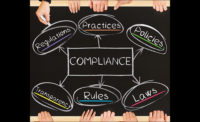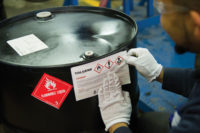There’s an awful lot to consider, but let’s zero in on a few important, often neglected points.
Know what’s covered
For starters, some employers still do not realize that substances covered in these standards are not limited to liquids, flammables, carcinogens, corrosives — the obvious choices. Does your program address germane fibers, dusts, colloids and pastes, pellets (e.g., melted plastics), and so on? How about compressed gas, grinding wheels, welding rods, tars, abrasive blasting materials (especially silica and beryllium), treated wood ingredients (especially formaldehyde and arsenic), and metals and coatings exposed to welding/burning heat (fumes being a major concern)?
You may have a few exempt substances, but the most efficient plan of attack is to assume everything is covered. This includes consumer products, if they are used in greater quantities, or in a different way, than used by consumers.
Are items labeled?
You probably receive all relevant materials with proper labels. I urge you to orient 55-gallon drums with the label clearly visible. Too commonly, the label faces “away†and is on a drum that is so positioned, and so heavy, that the label cannot be reasonably accessed.Generally, problems begin when you transfer to a secondary container, which must be marked with the identity of the substance and an appropriate hazard warning. “Caution†is not an appropriate hazard warning. “FLAMMABLE,†“COMBUSTIBLE,†“CORROSIVE,†“LUNG CARCINOGEN†and “SKIN IRRITANT†are examples of terms that could fulfill the requirement, or at least comprise a portion of the warning.
Also remember to label all tanks, cylinders, vats and other permanent containers. This is an area that often seems to go neglected, particularly with plating tanks.
And one other note: geometric shapes, with number or symbol systems, do not automatically suffice as acceptable labels. They make the grade if supplemented by unambiguous wording.
Have MSDSs in order
You have all of the necessary material safety data sheets (MSDSs) — or do you? If a vendor offers to leave you a free trial sample, forget it unless it’s accompanied by an MSDS and properly labeled. Besides the book(s) of MSDSs that may be in the safety office, purchasing office, maintenance room and other locations, keep an easy-to-access, loose set on hand so that the pertinent sheet can be tossed into an ambulance or brought to the hospital if needed.As a former OSHA compliance officer, I have witnessed a company take about 20 minutes to locate an MSDS, after I read the identity from the label. These cases arise when brand names, chemical names and/or synonyms are used; the substance identity on the label must match the one on the MSDS. One easy fix for this is to place an unambiguous number on every label. That number would consistently be in a pre-set position, form, color, etc. Then, to locate an MSDS, just look by way of the number. That number must be “findable†in simple consecutive 1-2-3 order. Do you think that’s obvious? Well, I have read locator maps (for tourists) where lodgings, restaurants and attractions are in a list in numerical order, but the places are scattered in the map where consecutive numbers are nowhere near each other!
You might want to consider using some fancy purchase-order wording, specifically indicating that you will not take receipt of the substance without the inclusion of a label and MSDS complying with the standards. To add clarity to your concerns, list the standard designations. Thus, your communication to the manufacturer or distributor would rise above and beyond any fine-print generic language about meeting all laws, codes and the like.
Training: keep it simple
As for training, you don’t have to make every employee into a chemist. It is not essential that every potentially exposed employee understands the complete meaning of, say, specific gravity. Or, employees need not memorize the exact vapor density.What is essential is that your training gets down to a practical and comprehensible level and detail. Employees should know how the chemical can enter the body (respire, eat/drink, through the skin), what adverse effects it can cause, with what is it not compatible, what personal protective equipment is needed, what should be done if there is a leak or release, can it — or its vapors or a dust concentration — explode, and what are warning signs (such as sound, smell, temperature) of danger.
Further, employees must understand who can authoritatively respond to questions about the substance, and how to access MSDSs at any time. Annual training is not an obligation, but is undoubtedly advisable. Additional training or retraining is called for when a chemical is used differently (perhaps at a significantly greater heat), when chemicals will be combined as they had not been previously, and upon employee transfer to where exposure to additional substances will become a concern. These are just some scenarios where training, other than initial, is important.

